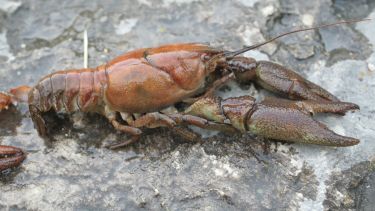Saving º¬Ð߲ݴ«Ã½'s white-clawed crayfish

Project background
The UK native white-clawed crayfish (Austropotamobius pallipus) crayfish is under considerable pressure throughout the UK from the invasive American signal crayfish and a fungal pathogen (crayfish plague) that it carries. Until recently there were sites with remaining populations of white-claw crayfish in º¬Ð߲ݴ«Ã½, but one of those is now extinct and the other vulnerable. If no action is taken the white-clawed crayfish populations in º¬Ð߲ݴ«Ã½ could become extinct in the next few years.
The key partners in the project to save º¬Ð߲ݴ«Ã½'s native crayfish were brought together as the º¬Ð߲ݴ«Ã½ Crayfish Working Group, who’s members are drawn from a range of conservation organizations in the º¬Ð߲ݴ«Ã½ District.
The Crayfish Action º¬Ð߲ݴ«Ã½ project aimed to document, monitor and conserve º¬Ð߲ݴ«Ã½â€™s important native crayfish populations through habitat enhancement, public education and the creation of bio-secure 'Ark' sites.
Project aims
- To survey current populations of white-clawed and non-native signal crayfish
- To raise awareness of the importance of the conservation of white-clawed crayfish among the general public and waterways users
- To engage with and train volunteers in crayfish conservation.
- To record data on the spatial and temporal distribution of white-clawed and non-native crayfish in º¬Ð߲ݴ«Ã½ and to disseminate these data to interested organizations.
- To identify off-line water bodies to act as ‘Ark sites’ for safeguarding the native crayfish population and create Ark populations.
Key outcomes
- The distributional data have provided valuable information on where to prioritize conservation efforts for white-clawed crayfish.
- º¬Ð߲ݴ«Ã½ carried out monitoring of crayfish populations in particular º¬Ð߲ݴ«Ã½ rivers, including documenting the extinction of one population.
- The project engaged with over 40 volunteers and has provided training in survey methods, identification and data handling. Several volunteers have been involved in translocation work.
- The project delivered numerous talks and attended public events. Levels of awareness have been raised, especially amongst angling groups.
- Spatial and temporal mapping of crayfish records were done by º¬Ð߲ݴ«Ã½ City Council Ecology Service.
- The project investigated, and set up a number of ark sites. The long term monitoring of these Ark sites will be an important legacy of the Crayfish Action º¬Ð߲ݴ«Ã½ project.
Additional details
Funding:
Acknowledgements: The Esmée Fairburn Foundation provided funding for the initial Crayfish Action project (now complete) and currently The º¬Ð߲ݴ«Ã½ and Rotherham Wildlife Trust coordinates the Crayfish Working Group.
